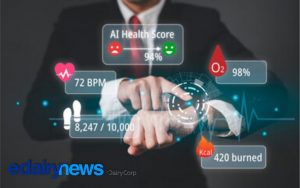
Last week my classmates and I presented our final projects for the Cornell Dairy Fellows program, which serves as an opportunity to synthesize all the things we’ve learned throughout our undergraduate experiences. Our task was to create the dairy farm of the future. Each group came up with creative ideas that addressed the areas we anticipated would be critical for the success of the dairy industry in the next 10 to 15 years: sustainability, animal welfare, consumer communication, and the need for nutritious food for a growing population.
When the assignment was first discussed at the beginning of the semester, we all had very different ideas. One group was going to build a dairy that was 30,000 cows, one with 80, and several in between. No matter what the idea was, we had to present it with budgets for the major building requirements and estimates for what our income would be so that our ideas were economically viable.
We worked on these projects throughout the semester. When the day came to present, all five groups had very different ideas, but there were some striking similarities. Two groups built moderately sized dairies with automated milking systems in the Midwest and Pacific Northwest. One group milked 100 cows in conjunction with trade-based education systems within the local school district and also produced cheese. One group milked a mixed breed herd, the others milked purebreds. These theoretic dairies were located on various land bases with differing crop plans, and they were scattered across the country.
The farms were big, small, value-added, diversified, and everything in between. Despite these differentials, there were two main topics that each proposed solution had in common.
First, they all had plans to capture methane, as well as mitigate and measure greenhouse gas emissions. Nutrient management plans were applied to all dairy farms of all sizes, and budgets were compiled for all of the proposed equipment. By-products were incorporated into the nutrient plans whenever possible in order to maximize the recycling potential of each farm.
Second, all of these futuristic farms developed plans to establish themselves in their communities and develop their social license. They didn’t shy away from interacting with consumers. They stepped up to the task and developed a proactive approach to managing the reputation of their brand and the consumer understanding of the dairy industry. These plans included animal welfare audits, employee well-being, and opening the operation to the public in a way that made dairy farming seem approachable and honest.
There is no cookie-cutter solution to the future of dairy. Each of these theoretical dairy farms addressed the key issues in different ways, and they had to justify why that way would work for them. One size doesn’t fit all in agriculture. The only things the future of agriculture must encompass are adaptability, persistence, and consumer understanding.
Abbie Cox grew up in Cato, N.Y. on a first-generation dairy farm and currently attends Cornell University as a member of the class of 2021, majoring in ani-mal science with a minor in education and a focus in dairy. On campus, she is involved with the Cornell University Dairy Science Club, Sigma Alpha, Collegiate Farm Bureau, and is a Peer Adviser with CALS Student Services. Cox has interned with the MILC group, the Animal Agriculture Alliance, and was the 2020 Hoard’s Dairyman summer editorial in-tern.























